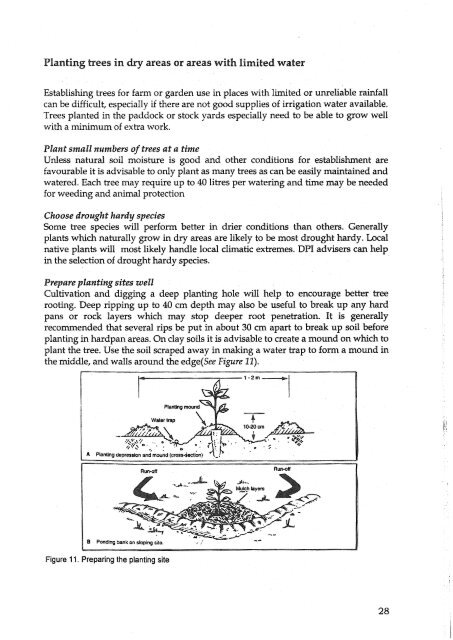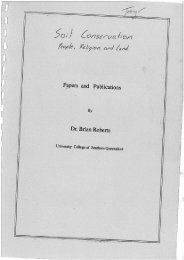western-queensland-gardening-guide.pdf - South West NRM
western-queensland-gardening-guide.pdf - South West NRM
western-queensland-gardening-guide.pdf - South West NRM
Create successful ePaper yourself
Turn your PDF publications into a flip-book with our unique Google optimized e-Paper software.
Planting trees in dry areas or areas with limited water<br />
Establishing trees for farm or garden use in places with limited or unreliable rainfall<br />
can be difficult, especially if there are not good supplies of irrigation water available.<br />
Trees planted in the paddock or stock yards especially need to be able to grow well<br />
with a minimum of extra work.<br />
Plant small numbers of trees at a time<br />
Unless natural soil moisture is good and other conditions for establishment are<br />
favourable it is advisable to only plant as many trees as can be easily maintained and<br />
watered. Each tree may require up to 40 litres per watering and time may be needed<br />
for weeding and animal protection<br />
Choose drought hardy species<br />
Some tree species will perform better in drier conditions than others. Generally<br />
plants which naturally grow in dry areas are likely to be most drought hardy. Local<br />
native plants will most likely handle local climatic extremes. DPI advisers can help<br />
in the selection of drought hardy species.<br />
Prepare planting sites well<br />
Cultivation and digging a deep planting hole will help to encourage better tree<br />
rooting. Deep ripping up to 40 cm depth may also be useful to break up any hard<br />
pans or rock layers which may stop deeper root penetration. It is generally<br />
ended that several rips be put in about 30 cm apart to break up soil before<br />
B Ponding bank on sloping site. I I<br />
--<br />
Figure 11. Preparing the planting site
















